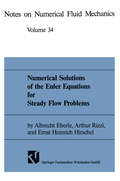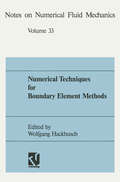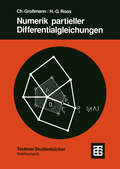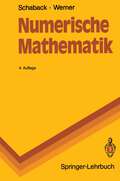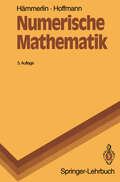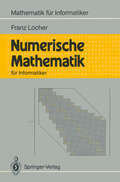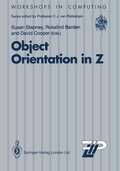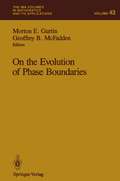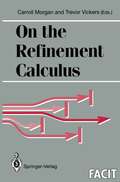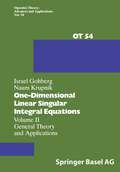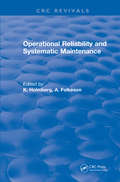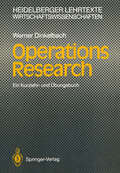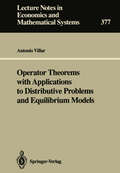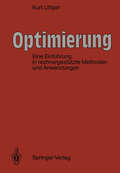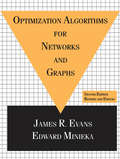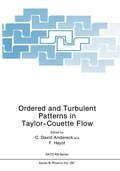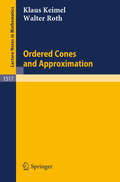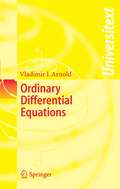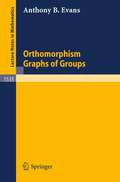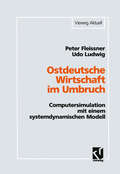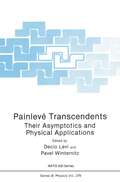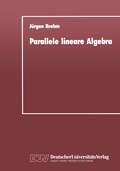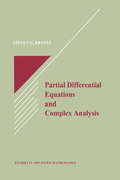- Table View
- List View
Numerical Solutions of the Euler Equations for Steady Flow Problems (Notes On Numerical Fluid Mechanics Ser. #48)
by Albrecht Eberle Arthur Rizzi Ernst Heinrich HirschelThe last decade has seen a dramatic increase of our abilities to solve numerically the governing equations of fluid mechanics. In design aerodynamics the classical potential-flow methods have been complemented by higher modelling-level methods. Euler solvers, and for special purposes, already Navier-Stokes solvers are in use. The authors of this book have been working on the solution of the Euler equations for quite some time. While the first two of us have worked mainly on algorithmic problems, the third has been concerned off and on with modelling and application problems of Euler methods. When we started to write this book we decided to put our own work at the center of it. This was done because we thought, and we leave this to the reader to decide, that our work has attained over the years enough substance in order to justify a book. The problem which we soon faced, was that the field still is moving at a fast pace, for instance because hyper sonic computation problems became more and more important.
Numerical Techniques for Boundary Element Methods: Proceedings of the Seventh GAMM-Seminar Kiel, January 25–27, 1991 (Notes on Numerical Fluid Mechanics and Multidisciplinary Design #33 7)
by Wolfgang HackbuschNumerik partieller Differentialgleichungen (Teubner Studienbücher Mathematik)
by Christian Großmann Hans-Görg Roos"Die Numerik partieller Differentialgleichungen wird hier in relativ weitem Umfang vorgeführt: es beginnt bei der Diskretisierung der ursprünglichen Gleichungen, es werden Fragen der Konsistenz und Stabilität behandelt, und auch Fragen der zweckmäßigen Lösung der entstehenden Gleichungen werden nicht wie sonst in vergleichbaren Büchern verschiedentlich, zur Seite geschoben." Monatshefte für Mathematik. H.Muthsam, Wien
Numerische Mathematik (Springer-Lehrbuch)
by Günther Hämmerlin Karl-Heinz HoffmannDieser Band Numerische Mathematik hat Prinzipien des numerischen Rechnens, numerische lineare Algebra und Näherungsmethoden in der Analysis zum Inhalt. Der Begriff der Approximation zieht sich als roter Faden durch den gesamten Text. Die Betonung liegt dabei weniger auf der Bereitstellung möglichst vieler Algorithmen als vielmehr auf der Vermittlung mathematischer Überlegungen, die zur Konstruktion von Verfahren führen. Jedoch werden auch der algorithmische Aspekt und entsprechende Effizienzbetrachtungen gebührend berücksichtigt. An vielen Stellen wie etwa bei den Untersuchungen zur Komplexität von Algorithmen, bei der Behandlung schlecht konditionierter Probleme, in dem Abschnitt über Splines oder auch bei der numerischen Kubatur geht der dargebotene Stoff über den Inhalt einer einsemestrigen Vorlesung zur numerischen Mathematik hinaus, so daß man beim Gebrauch des Buches für eine solche Vorlesung eine Auswahl treffen wird. Zahlreiche historische Anmerkungen sowie Querverbindungen und motivierende Erklärungen runden dieses Buch ab. Wer glaubt, daß die "Numerische Mathematik" nur aus einer Ansammlung von Algorithmen zur Lösung von Problemen besteht, der hat dieses Buch noch nicht in der Hand gehabt. Die Autoren haben die Betonung auf die Vermittlung mathematischer Überlegungen, die zur Konstruktion von Verfahren führen gelegt, ohne dabei den algorithmischen Aspekt und die entsprechende Effizienzsteigerung zu vernachlässigen. Zahlreiche historische Anmerkungen, Querverbindungen und motivierende Erklärungen haben dieses Buch zu einen Juwel der Lehrbücher zur "Numerischen Mathematik" gemacht.
Object Orientation in Z (Workshops in Computing)
by Susan Stepney Rosalind Barden David CooperThis collection of papers draws together a variety of approaches for adding ob ject orientation to the Z formal specification language. These papers are not a conference proceedings, but have a slightly more complicated his tory. This work has grown and evolved from some work originally done in the ZIP project, under the United Kingdom's Department of Trade and Industry (DTI) IED initiative. ZIP is a three year project which aims to make the use of the Z specification language more widespread. It hopes to achieve this by producing a standard for Zj developing a method for Zj building tool support for Zj and carrying out research into refinement, proof and concurrency in Z. The ZIP methods work includes performing a survey of current Z practitioners (reported in [Barden et al. 1992])j investigating current styles and methods of Z usagej and developing a Z Method handbook (available early in 1993). As part of this work, we carried out a comparative study of the ways in which object orientation has been combined with Z. A summary of that work has been published as [Stepney et al. 1992].
On the Evolution of Phase Boundaries (The IMA Volumes in Mathematics and its Applications #43)
by Morton E. Gurtin Geoffrey B. McFaddenThis IMA Volume in Mathematics and its Applications ON THE EVOLUTION OF PHASE BOUNDARIES is based on the proceedings of a workshop which was an integral part of the 1990- 91 IMA program on "Phase Transitions and Free Boundaries". The purpose of the workshop was to bring together mathematicians and other scientists working on the Stefan problem and related theories for modeling physical phenomena that occurs in two phase systems. We thank M.E. Gurtin and G. McFadden for editing the proceedings. We also take this opportunity to thank the National Science Foundation, whose financial support made the workshop possible. A vner Friedman Willard Miller, Jr. PREFACE A primary goal of the IMA workshop on the Evolution of Phase Boundaries from September 17-21, 1990 was to emphasize the interdisciplinary nature of contempo rary research in this field, research which combines ideas from nonlinear partial dif ferential equations, asymptotic analysis, numerical computation, and experimental science. The workshop brought together researchers from several disciplines, includ ing mathematics, physics, and both experimental and theoretical materials science.
On the Refinement Calculus (Formal Approaches to Computing and Information Technology (FACIT))
by Carroll Morgan Trevor VickersOn the Refinement Calculus gives one view of the development of the refinement calculus and its attempt to bring together - among other things - Z specifications and Dijkstra's programming language. It is an excellent source of reference material for all those seeking the background and mathematical underpinnings of the refinement calculus.
One-Dimensional Linear Singular Integral Equations: Volume II General Theory and Applications (Operator Theory: Advances and Applications #54)
by I. Gohberg N. KrupnikThis monograph is the second volume of a graduate text book on the modern theory of linear one-dimensional singular integral equations. Both volumes may be regarded as unique graduate text books. Singular integral equations attract more and more attention since this class of equations appears in numerous applications, and also because they form one of the few classes of equations which can be solved explicitly. The present book is to a great extent based upon material contained in the second part of the authors' monograph [6] which appeared in 1973 in Russian, and in 1979 in German translation. The present text includes a large number of additions and complementary material, essentially changing the character, structure and contents of the book, and making it accessible to a wider audience. Our main subject in the first volume was the case of closed curves and continuous coeffi cients. Here, in the second volume, we turn to general curves and discontinuous coefficients. We are deeply grateful to the editor Professor G. Heinig, to the translator Dr. S. Roeh, and to the typist Mr. G. Lillack, for their patient work. The authors Ramat-Aviv, Ramat-Gan, May 26, 1991 11 Introduction This book is the second volume of an introduction to the theory of linear one-dimensional singular integral operators. The main topics of both parts of the book are the invertibility and Fredholmness of these operators. Special attention is paid to inversion methods.
Operational Reliability and Systematic Maintenance
by K. HolmbergScientists from four countries cooperated in a reseach effort aimed at the imporvement of operational reliability via innovations in design and testing and systematic maintenance. The scientists had varied backgrounds ranging from mathematic to applied mechanical engineering, and the results fo this effort are documented in this book.
Operational Reliability and Systematic Maintenance
by K. HolmbergScientists from four countries cooperated in a reseach effort aimed at the imporvement of operational reliability via innovations in design and testing and systematic maintenance. The scientists had varied backgrounds ranging from mathematic to applied mechanical engineering, and the results fo this effort are documented in this book.
Operations Research: Ein Kurzlehr- und Übungsbuch (Heidelberger Lehrtexte Wirtschaftswissenschaften)
by Werner DinkelbachOperator Theorems with Applications to Distributive Problems and Equilibrium Models (Lecture Notes in Economics and Mathematical Systems #377)
by Antonio VillarPresentation Many economic problems, as equilibrium models, input-output analysis, rational behaviour, etc. , are usually modelled in terms of operators in Euclidean spaces. This monograph deals with the analysis of a number of formal problems involving this kind of operators (with particular reference to complementarity problems and variational inequalities), and their applications to distributive problems and equilibrium models. Thus the purpose of this work is to provide a set of new results on the solvability of those problems, and a number of economic applications that will illustrate the interest of these results in economics. It is worth stressing from the very begining that our analysis concentrates on the existence (and in some cases optimality) of solutions. That is what is meant here by solvability (in particular, nothing will be said with respect to the uniqueness, stability, sensitivity analysis or computation of solutions). The results on the solvability of operator problems presented here, were actually arrived at as a way of solving specific economic models. Yet we are going to relate this case by somehow reversing the way it happened, that is, starting with the formal results and then presenting a number of economic models which appear as applications of VIII these formal results. The rationale for this approach is twofold. First, it provides a neat track via which to go through the whole work. Then, because I would like to emphasize the interest of complementarity and variational inequalities problems in economic modelling.
Optimierung: Eine Einführung in rechnergestützte Methoden
by Kurt LittgerOptimierung ist eine Aufgabe von besonderer Bedeutung für Unternehmen und Organisationen. Durch wachsenden Wettbewerb wird dieses Thema immer wichtiger. Hier wird es in einer Darstellungsform behandelt, die den Praktiker ohne große mathematische Vorkenntnisse in dieses komplexe Sachgebiet einführt. Hierbei werden theoretische (algorithmische) Aspekte konzeptionell behandelt und in Beziehung zu Aspekten der Datenverarbeitung (Software) sowie zu den Anwendungsgebieten gestellt, wie z.B. Standort-, Personal-, Produktions- und Vertriebsplanung von Unternehmen. Das Buch führt den Leser von den klassischen Methoden und Anwendungen bis zu den neuesten Verfahren und Problemstellungen betriebswirtschaftlicher und technischer Art. Es trägt dazu bei, dem großen Interessentenkreis aus den verschiedensten Branchen den Blick für die Möglichkeiten des rechnergestützten Optimierens zu öffnen. Von besonderem Wert für den Leser ist der einführende Charakter der Darstellung und das reichhaltige, strukturierte Literaturverzeichnis.
Optimization Algorithms for Networks and Graphs
by James EvansA revised and expanded advanced-undergraduate/graduate text (first ed., 1978) about optimization algorithms for problems that can be formulated on graphs and networks. This edition provides many new applications and algorithms while maintaining the classic foundations on which contemporary algorithm
Optimization Algorithms for Networks and Graphs
by James EvansA revised and expanded advanced-undergraduate/graduate text (first ed., 1978) about optimization algorithms for problems that can be formulated on graphs and networks. This edition provides many new applications and algorithms while maintaining the classic foundations on which contemporary algorithm
Ordered and Turbulent Patterns in Taylor-Couette Flow (Nato Science Series B: #297)
by C. David Andereck F. HayotSeldom does a physical system, particularly one as apparently simple as the flow of a Newtonian fluid between concentric rotating cylinders, retain the interest of scientists, applied mathematicians and engineers for very long. Yet, as this volume goes to press it has been nearly 70 years since G. I. Taylor's outstanding experimental and theoretical study of the linear stability of this flow was published, and a century since the first experiments were performed on rotating cylinder viscometers. Since then, the study of this system has progressed enormously, but new features of the flow patterns are still being uncovered. Interesting variations on the basic system abound. Connections with open flows are being made. More complex fluids are used in some experiments. The vigor of the research going on in this particular example of nonequilibrium systems was very apparent at the NATO Advanced Research Workshop on "Ordered and Turbulent Patterns in Taylor Couette Flow," held in Columbus, Ohio, USA May 22-24, 1991. A primary goal of this ARW was to bring together those interested in pattern formation in the classic Taylor Couette problem with those looking at variations on the basic system and with those interested in related systems, in order to better define the interesting areas for the future, the open questions, and the features common (and not common) to closed and open systems. This volume contains many of the contributions presented during the workshop.
Ordered Cones and Approximation (Lecture Notes in Mathematics #1517)
by Klaus Keimel Walter RothThis book presents a unified approach to Korovkin-type approximation theorems. It includes classical material on the approximation of real-valuedfunctions as well as recent and new results on set-valued functions and stochastic processes, and on weighted approximation. The results are notonly of qualitative nature, but include quantitative bounds on the order of approximation. The book is addressed to researchers in functional analysis and approximation theory as well as to those that want to applythese methods in other fields. It is largely self- contained, but the readershould have a solid background in abstract functional analysis. The unified approach is based on a new notion of locally convex ordered cones that are not embeddable in vector spaces but allow Hahn-Banach type separation and extension theorems. This concept seems to be of independent interest.
Ordinary Differential Equations (Universitext)
by Vladimir I. ArnoldThe first two chapters of this book have been thoroughly revised and sig nificantly expanded. Sections have been added on elementary methods of in tegration (on homogeneous and inhomogeneous first-order linear equations and on homogeneous and quasi-homogeneous equations), on first-order linear and quasi-linear partial differential equations, on equations not solved for the derivative, and on Sturm's theorems on the zeros of second-order linear equa tions. Thus the new edition contains all the questions of the current syllabus in the theory of ordinary differential equations. In discussing special devices for integration the author has tried through out to lay bare the geometric essence of the methods being studied and to show how these methods work in applications, especially in mechanics. Thus to solve an inhomogeneous linear equation we introduce the delta-function and calculate the retarded Green's function; quasi-homogeneous equations lead to the theory of similarity and the law of universal gravitation, while the theorem on differentiability of the solution with respect to the initial conditions leads to the study of the relative motion of celestial bodies in neighboring orbits. The author has permitted himself to include some historical digressions in this preface. Differential equations were invented by Newton (1642-1727).
Orthomorphism Graphs of Groups (Lecture Notes in Mathematics #1535)
by Anthony B. EvansThis book is about orthomorphisms and complete mappings of groups, and related constructions of orthogonal latin squares. It brings together, for the first time in book form, many of the results in this area. The aim of this book is to lay the foundations for a theory of orthomorphism graphsof groups, and to encourage research in this area. To this end, many directions for future research are suggested. The material in this book should be accessible to any graduate student who has taken courses in algebra (group theory and field theory). It will mainly be useful in research on combinatorial design theory, group theory and field theory.
Ostdeutsche Wirtschaft im Umbruch: Computersimulation mit einem systemdynamischen Modell
by Peter FleissnerPainlevé Transcendents: Their Asymptotics and Physical Applications (Nato Science Series B: #278)
by Decio Levi Pavel WinternitzThe NATO Advanced Research Workshop "Painleve Transcendents, their Asymp totics and Physical Applications", held at the Alpine Inn in Sainte-Adele, near Montreal, September 2 -7, 1990, brought together a group of experts to discuss the topic and produce this volume. There were 41 participants from 14 countries and 27 lectures were presented, all included in this volume. The speakers presented reviews of topics to which they themselves have made important contributions and also re sults of new original research. The result is a volume which, though multiauthored, has the character of a monograph on a single topic. This is the theory of nonlinear ordinary differential equations, the solutions of which have no movable singularities, other than poles, and the extension of this theory to partial differential equations. For short we shall call such systems "equations with the Painleve property". The search for such equations was a very topical mathematical problem in the 19th century. Early work concentrated on first order differential equations. One of Painleve's important contributions in this field was to develop simple methods applicable to higher order equations. In particular these methods made possible a complete analysis of the equation ;; = f(y',y,x), where f is a rational function of y' and y, with coefficients that are analytic in x. The fundamental result due to Painleve (Acta Math.
Parallele lineare Algebra: Parallele Lösungen ausgewählter linearer Gleichungssysteme bei unterschiedlichen Multiprozessor-Architekturen
by Jürgen BrehmPartial Differential Equations and Complex Analysis (Studies in Advanced Mathematics #6)
by Steven G. KrantzEver since the groundbreaking work of J.J. Kohn in the early 1960s, there has been a significant interaction between the theory of partial differential equations and the function theory of several complex variables. Partial Differential Equations and Complex Analysis explores the background and plumbs the depths of this symbiosis. The book is an excellent introduction to a variety of topics and presents many of the basic elements of linear partial differential equations in the context of how they are applied to the study of complex analysis. The author treats the Dirichlet and Neumann problems for elliptic equations and the related Schauder regularity theory, and examines how those results apply to the boundary regularity of biholomorphic mappings. He studies the ?-Neumann problem, then considers applications to the complex function theory of several variables and to the Bergman projection.
